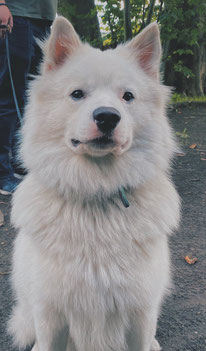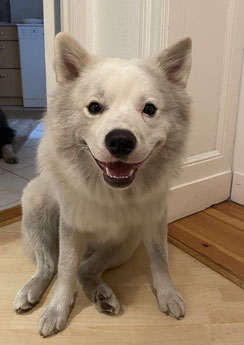Birk vom Roten Turm - Birk (Chudzinski)
How I owned Birki

After I delved a little deeper into the whole Spitz matter after Kuno moved in, I found out that the Giant Spitz is threatened with extinction, so it was immediately clear to me that a possible second dog should definitely be a Giant Spitz. Originally, I wanted to wait until Kuno was two or, better yet, three years old. Of course, things turned out differently:
By chance, in the summer of 2020, my attention fell on a fresh litter in Bavaria that had just been entered into the Spitzdatenbank (Spitz database) and was only a few days old. Without thinking too much, I contacted the breeder and promptly received the answer that a white male would probably be available. Said male became available and moved in almost twelve weeks later.
Birk's character

Even as a puppy, Birki's temperament was rather very "spitzy". As a little pup, he barked and growled at strangers and unknown dogs. He is suspicious, but he can be petted by strangers in my presence. He loves being the center of attention and once, for example, completely forgot his fear of it while riding the tram because he was so admired by a school class. He even let several children pet him at the same time.
Birk is quite suspicious, and I can only advise against anyone touching him when I'm not there. He doesn't just bark! He is a cheerful, cheeky clown who also likes to see how far he can go with other people (and even the master) and whether they will let him make fun of them. However, he does it in a very charming way.

In contrast to Kuno, Birki clearly has more desire to please. He is less stubborn than Kuno and also more cautious without being fearful. On the other hand, he masterfully manages to elegantly evade existing rules. 😉
Otherwise, Birki does everything a dog can do: he accompanies by me to the hairdresser, to the restaurant or shopping in town. He can wait for me in front of the bakery, guard my purchases, and ride with me on public transport or on the cargo bike. Because we live in the city and see all sorts of people and animals, Birk isn't particularly interested in wheelchair users or screaming children, for example. At home, Birki is the one among the dogs who report the intruders, while Kuno stays in the background.
Like Kuno, Birki can do tricks, although I haven't taught him a single one. He copied them all from Kuno because he saw that they had treats for him. And Birki is always hungry - despite our feeding model means that there is always food available. But dried food is also really boring....😉
By the way, the name Birk is the Nordic short form of the German name Burkhart and means something like "strong protector" (castle = refuge, protection; herti = hard, strong, powerful). Furthermore, Birk itself also means “radiant or bright white”. I think this name suits him incredibly well.
Stud dog - or not?
I originally did not want Birk to become a stud dog due to his loss of pigment in his left eye and lips, which could possibly be related to his piebald.
Yes? No? Maybe? YES!

Since dogs with similar pigmentation problems are usually removed from breeding, I actually wanted to join in with this old breeding consensus. With Birki, however, I have come to the conclusion that his positive qualities definitely compensate for his flaws. Despite his pigmentation, he could contribute a lot to the preservation of the old Spitz type because:
- Birk has an impeccable Spitz character, is very alert and, to a manageable degree, suspicious of strangers.
- He naturally has a well-developed but controllable protectiveness.
- His body is built with very good substance and excellent angulation of the hind limbs.
- Birk's double-coated fur is thick, very dense and firm in structure. It is extremely easy to care for.
- He has no hunting drive at all.
The population size of the Giant Spitz is also an important thing here: precisely because the Giant Spitzes are stuck in a very tight bottleneck, dogs with (tolerable) defects also logically have to be bred. And not just the champions!
Birk is now a registered dog in the German Spitz Club ("Verein für Deutsche Spitze") and has a new surname: he is no longer called by his litter name "Birk vom Roten Turm" but "Birk (Chudzinski)" and officially has no known ancestors - although 99% of his ancestors were bred in the FCI. Registration law. Understand this, whoever wants!
30.04.23




